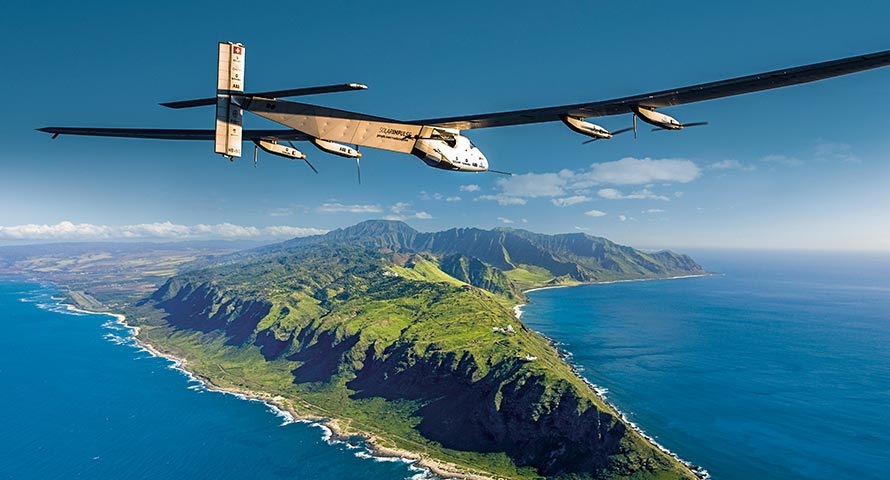Solar Plane Soars into History
Talk about proof of concept!
While solar-powered cars have yet to cruise much beyond design competitions, Swiss engineer André Borschberg soared across the Pacific and into the history books when he touched down in Hawaii on July 3, 2015, five days after taking off from Nagoya, Japan in a solar-powered plane.
The flight was an important leg in an epic globe-circling journey of Solar Impulse 2, a single-seat, carbon-fiber aircraft covered with 12,000 photovoltaic panels. The solar cells charge four batteries that keep four 17.4-horsepower motors going at night, when the plane descends to 5,000 feet from 28,000 feet to reduce energy consumption.
The quest to prove that clean technology can apply even to aviation successfully culminated on July 26. 2016, when the plane touched down in Abu Dhabi. The feat caps 12 years of feasibility studies, designing, and testing that involved 50 engineers and technicians, 80 technological partners, and 100 advisers. It has included a smaller prototype plane and shorter hops across Europe – notably from Spain to Morocco in 2012 and a first overnight flight in 2010 – and the United States to hone the technology.
Solar Impulse 2’s latest voyage began in Abu Dhabi in April. Bad weather bogged it down in China – the 5,000-pound plane can’t fly through storms or heavy winds, as did the rainy season in Japan. The pilot – spelled by the project’s co-founder and co-pilot, Bertrand Piccard, who took the helm remotely from ground control in Monaco – finally took off from Japan on June 28, covering 4,481 miles in just under 118 hours.
 Technology and weather weren’t the only challenges in navigating the plane safely to Hawaii. With no room to stand or move around in the cramped, unpressurized cockpit – the toilet is built into the seat – the pilot turned to meditation to stay fit and alert. He also made the tough decision to forge on after discovering that the autopilot’s surveillance system, which would alert him to flight abnormalities while he was asleep, wasn’t working.
Technology and weather weren’t the only challenges in navigating the plane safely to Hawaii. With no room to stand or move around in the cramped, unpressurized cockpit – the toilet is built into the seat – the pilot turned to meditation to stay fit and alert. He also made the tough decision to forge on after discovering that the autopilot’s surveillance system, which would alert him to flight abnormalities while he was asleep, wasn’t working.
Mobbed by news teams in Honolulu, Borschberg and Piccard underscored the flight’s purpose is to demonstrate that “cleantech solutions already exist in the fight against climate change.” The Solar Impulse website urges people to join their Future Is Clean campaign and help convince governments to commit to reducing emissions at the United Nations’ upcoming Conference on Climate Change this December in Paris.
Next stop for the Solar Impulse 2: Phoenix, Arizona. Then it’s on to the midwest, New York, and eventually back to Abu Dhabi.
Filed under: Special Features
Tags: Aerospace, aircraft, airplane, André Borschberg, Aviation, Bertrand Piccard, Design, Environmental Engineering, Solar Energy, Solar Impulse 2, Sustainability








